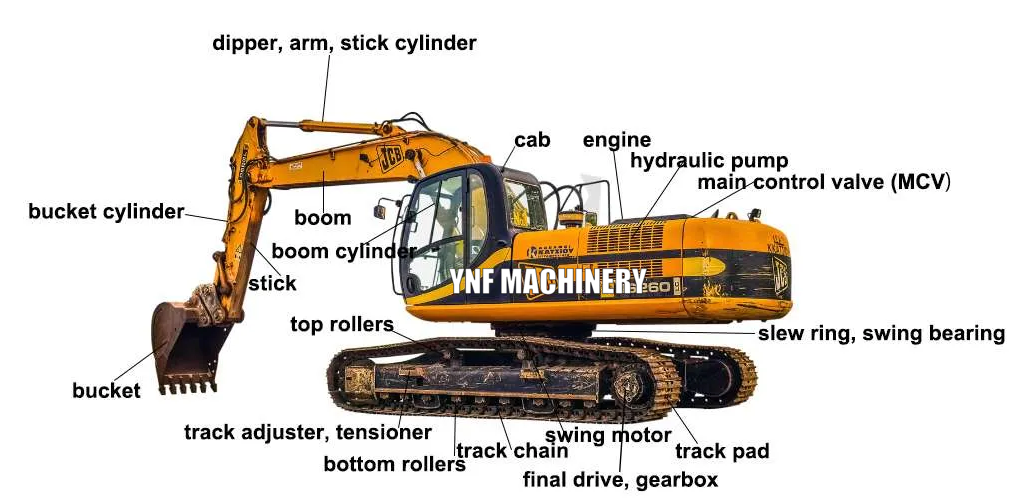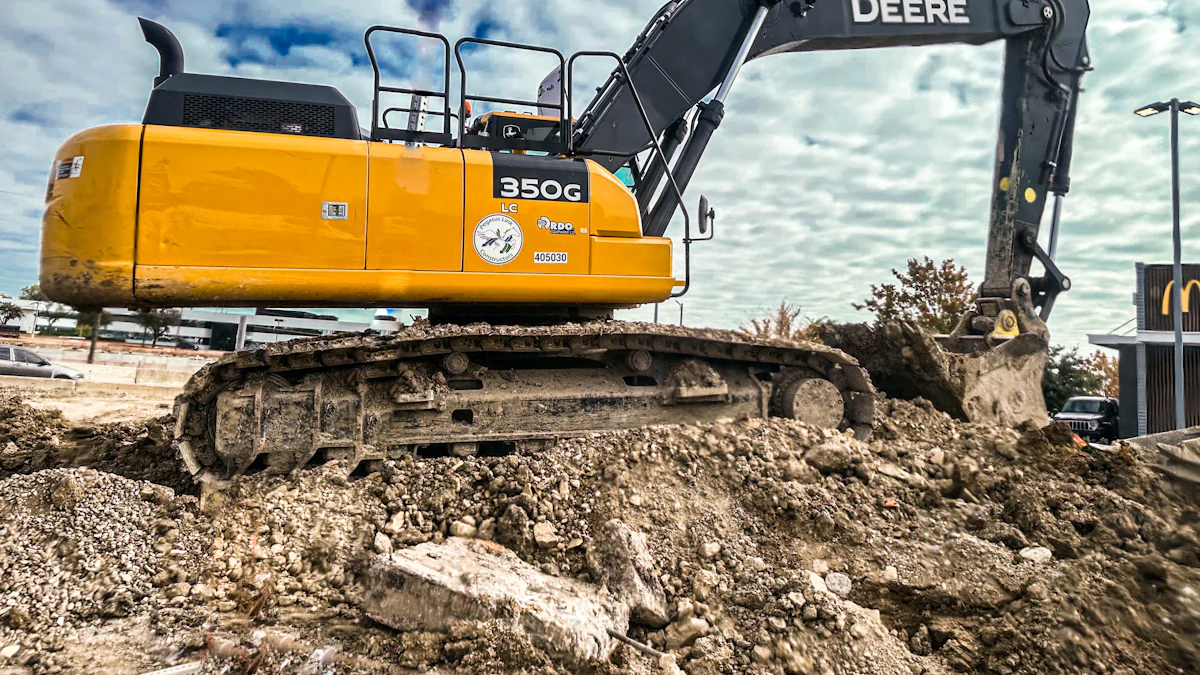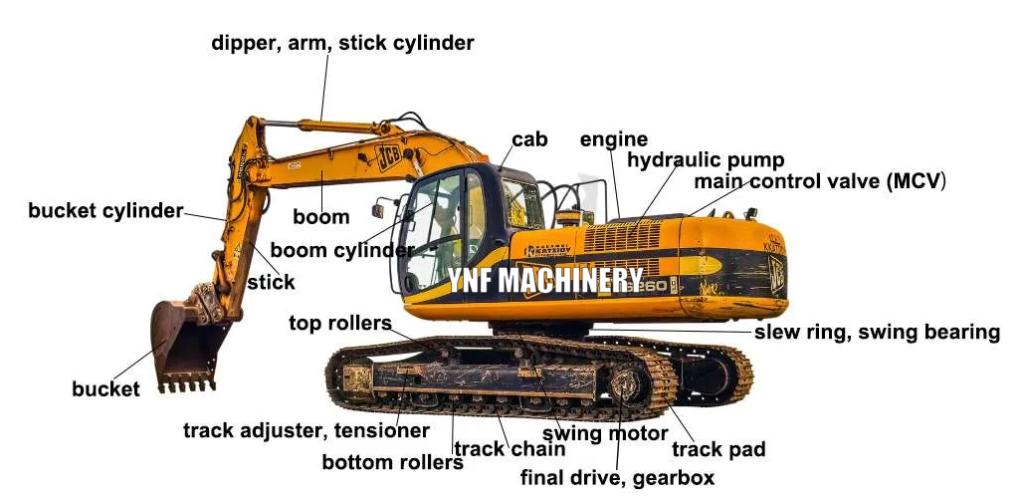
Mastering excavator parts diagrams plays a crucial role in accurate identification. You prevent costly errors and downtime by correctly identifying parts. Diagrams serve as a universal language among technicians, enhancing communication and ensuring everyone is on the same page. Understanding the excavator parts breakdown helps you maintain efficiency and safety. With clear diagrams, you can quickly locate and identify components, streamlining maintenance and repairs. This knowledge empowers you to make informed decisions, ultimately saving time and resources.
The Importance of Accurate Excavator Parts Identification
Accurate identification of excavator parts is essential for maintaining the efficiency and longevity of your machinery. Understanding the excavator parts breakdown through diagrams can help you avoid costly mistakes and ensure smooth operations.
Consequences of Misidentification
Increased Repair Costs
Using incorrect parts in your excavator can lead to significant financial burdens. When you install the wrong component, it may not fit or function properly, causing damage to other parts of the machine. This mistake often results in additional repair costs that could have been avoided with proper identification. By ensuring you use the correct parts, you maintain the machine’s performance and efficiency, ultimately saving money.
Equipment Downtime
Misidentification of parts can also lead to extended equipment downtime. When your excavator is out of service due to incorrect parts, your projects face delays, affecting productivity and profitability. Quick and accurate identification of parts minimizes downtime, allowing you to keep your operations running smoothly. This efficiency is crucial for meeting deadlines and maintaining client satisfaction.
Benefits of Correct Identification
Improved Maintenance Efficiency
Correct identification of excavator parts enhances maintenance efficiency. When you know exactly which parts are needed, you streamline the repair and maintenance process. This precision reduces the time spent on troubleshooting and ensures that your excavator operates at peak performance. Efficient maintenance practices also contribute to the overall health and longevity of your equipment.
Enhanced Safety
Safety is paramount when operating heavy machinery like excavators. Using the right parts ensures that your equipment functions safely and reliably. Incorrect parts can compromise the structural integrity of the machine, posing risks to operators and bystanders. By prioritizing accurate identification, you enhance safety standards and protect everyone involved in the operation.
Incorporating tools like a cat parts lookup can further aid in the precise identification of components, ensuring you always have the right parts for your excavator. This proactive approach not only safeguards your investment but also promotes a culture of safety and efficiency in your operations.
Understanding Excavator Parts Diagrams

Excavator parts diagrams serve as a vital tool for anyone involved in the maintenance or repair of these powerful machines. These diagrams provide a comprehensive overview of all components, making it easier to identify and specify the exact parts needed. By familiarizing yourself with these diagrams, you can enhance your understanding of the excavator’s structure and function.
Common Symbols and Notations
When you look at an excavator parts diagram, you’ll notice various symbols and notations. These symbols represent different components and systems within the machine.
Mechanical Symbols
Mechanical symbols in parts diagrams often depict components like the boom, bucket, and undercarriage. These symbols help you quickly locate and identify mechanical parts. Understanding these symbols is crucial for effective communication and accurate identification. For instance, the boom symbol indicates the arm that extends from the excavator, while the bucket symbol represents the attachment used for digging.
Electrical Symbols
Electrical symbols in diagrams represent the wiring and electrical systems of the excavator. These symbols are essential for troubleshooting electrical issues and ensuring proper connections. Familiarity with these symbols allows you to identify electrical components accurately, aiding in maintenance and repair tasks.
Reading and Interpreting Diagrams
To effectively use excavator parts diagrams, you need to know how to read and interpret them. This skill ensures you can locate and identify parts efficiently.
Layout and Orientation
The layout and orientation of a parts diagram provide a visual map of the excavator. You should pay attention to how components are arranged and their relative positions. This understanding helps you navigate the diagram and locate specific parts quickly. For example, the boom and bucket are typically shown in their operational positions, giving you a clear reference for their location on the machine.
Key and Legend Usage
Diagrams often include a key or legend that explains the symbols and notations used. You should always refer to this section to understand what each symbol represents. The key provides clarity and ensures you interpret the diagram correctly. By using the key, you can cross-reference symbols with their corresponding parts, enhancing your identification accuracy.
By mastering the reading and interpretation of excavator parts diagrams, you empower yourself to make informed decisions during maintenance and repairs. This knowledge not only saves time but also ensures the longevity and efficiency of your excavator.
Step-by-Step Guide to Identifying Excavator Parts

Navigating the world of excavator maintenance becomes much simpler when you know how to use parts diagrams effectively. This guide will walk you through the process of identifying excavator parts with precision.
Preparing to Use Diagrams
Before diving into the diagrams, you need to prepare adequately. This preparation ensures you can make the most of the information provided.
Gathering Necessary Tools
Start by assembling the tools you’ll need. A reliable flashlight helps illuminate hard-to-see areas on your excavator. A magnifying glass can assist in examining small details on the diagram. Keep a notepad and pen handy for jotting down part numbers or notes. These tools will streamline your identification process.
Familiarizing with Diagram Layout
Take time to familiarize yourself with the layout of the parts diagrams. Each section of the excavator, such as the boom or bucket, is meticulously labeled. Understanding this layout helps you locate components quickly. Pay attention to the orientation of the diagram, as it mirrors the actual structure of the excavator. This familiarity speeds up the identification process and reduces errors.
Identifying Specific Parts
Once you’re prepared, you can begin identifying specific parts on your excavator. This step involves locating parts on the diagram and ensuring they match your machine.
Locating Parts on the Diagram
Use the diagram to locate the parts you need. Start by identifying major components like the boom and bucket. These parts are often prominently displayed, making them easier to find. Once you’ve located these, you can narrow down to smaller components. The diagram serves as a visual map, guiding you to the exact location of each part.
Cross-Referencing with Part Numbers
After locating a part on the diagram, cross-reference it with the part numbers in your machine’s manual. This step ensures compatibility and accuracy. The Cat Parts LookUp System can be a valuable resource here. It allows you to visually match parts and confirm their suitability for your specific model. If you’re unsure, don’t hesitate to reach out to customer service for assistance. This cross-referencing step is crucial for accurate identification and ordering of replacement parts.
By following this step-by-step guide, you enhance your ability to maintain and repair your excavator efficiently. Mastering the use of parts diagrams not only saves time but also ensures the longevity and performance of your machinery.
Troubleshooting Common Identification Issues
When working with excavator parts diagrams, you might encounter some challenges. These issues can hinder your ability to identify parts accurately. By understanding how to address these problems, you can ensure a smoother maintenance process.
Dealing with Ambiguous Diagrams
Sometimes, diagrams may not be as clear as you’d like. Ambiguities can arise due to unclear symbols or outdated information. Here’s how you can tackle these issues:
Consulting Manufacturer Resources
Always start by consulting the manufacturer’s resources. These resources often include detailed guides and updated diagrams. They provide clarity on any ambiguous symbols or notations. You can find these resources on the manufacturer’s website or in the equipment manual. By using these materials, you gain a better understanding of the excavator parts breakdown.
Seeking Expert Assistance
If manufacturer resources don’t resolve your confusion, seek expert assistance. Contact a professional with experience in excavator maintenance. They can offer insights and clarify any doubts you have. Experts can also provide practical advice on using diagrams effectively. This step ensures you make informed decisions during repairs.
Overcoming Diagram Misinterpretations
Misinterpretations can lead to incorrect part identification. To avoid this, follow these strategies:
Double-Checking Part Numbers
Always double-check part numbers against your machine’s manual. This step verifies that the part you’re identifying matches the diagram. Use tools like the cat parts lookup to cross-reference numbers. This tool helps confirm the compatibility of parts with your specific excavator model. Accurate part numbers prevent costly mistakes.
Verifying with Physical Parts
Verify your findings by comparing them with the physical parts on your excavator. This comparison ensures that the diagram matches the actual components. Look for unique features or markings on the parts. This verification step acts as a final check, ensuring accuracy in your identification process.
By addressing these common identification issues, you enhance your troubleshooting skills. This knowledge empowers you to maintain your excavator efficiently, reducing downtime and improving performance.
Tips for Mastering Excavator Parts Diagrams
Mastering excavator parts diagrams requires dedication and continuous learning. By investing time in understanding these diagrams, you enhance your ability to maintain and repair your machinery effectively. Here are some valuable tips to help you on this journey.
Continuous Learning and Practice
To become proficient in reading excavator parts diagrams, you must engage in continuous learning and practice. This approach ensures you stay updated with the latest techniques and information.
Attending Workshops
Participate in workshops focused on excavator maintenance and parts identification. These workshops provide hands-on experience and expert guidance. You gain insights from professionals who have firsthand knowledge of the field. Workshops also offer opportunities to ask questions and clarify doubts, enhancing your understanding of excavator controls and components.
Utilizing Online Resources
Leverage online resources to expand your knowledge. Many websites and platforms offer tutorials, videos, and articles on excavator parts diagrams. These resources allow you to learn at your own pace and revisit topics as needed. Online forums and communities also provide a space to connect with other enthusiasts and professionals, sharing experiences and tips.
Building a Reference Library
Creating a comprehensive reference library is essential for mastering excavator parts diagrams. This library serves as a valuable resource for quick access to information.
Collecting Manufacturer Manuals
Gather manufacturer manuals for the excavators you work with. These manuals contain detailed diagrams and specifications for each model. They provide accurate and reliable information, ensuring you have the correct references for parts identification. Keep these manuals organized and easily accessible for efficient use.
Creating Personal Notes
Develop personal notes based on your experiences and learnings. Document key points, tips, and insights gained from workshops and online resources. Personal notes help reinforce your understanding and serve as a quick reference during maintenance tasks. Regularly update these notes to reflect new knowledge and techniques.
By following these tips, you enhance your ability to interpret excavator parts diagrams accurately. Continuous learning and a well-organized reference library empower you to maintain your machinery efficiently, reducing downtime and improving performance.
YNF Machinery’s Role in Excavator Parts Breakdown
Understanding the intricacies of an excavator parts breakdown can be daunting. However, YNF Machinery simplifies this process for you. With over 35 years of experience, YNF Machinery stands as a reliable partner in the industry, ensuring you have access to high-quality parts and resources. This commitment helps you maintain your equipment efficiently and effectively.
How YNF Machinery Supports Accurate Identification
YNF Machinery plays a pivotal role in helping you accurately identify excavator parts. Their dedication to quality and customer satisfaction ensures you receive the best support possible.
Providing High-Quality Diagrams
YNF Machinery offers detailed and precise diagrams that are essential for accurate parts identification. These diagrams serve as a visual guide, allowing you to easily locate and identify components within your excavator. By using these high-quality diagrams, you minimize the risk of errors and ensure that you select the correct parts for your machinery. This precision not only saves you time but also reduces the likelihood of costly mistakes.
Offering Comprehensive Support
In addition to providing excellent diagrams, YNF Machinery offers comprehensive support to assist you in the identification process. Their team of experts is always ready to help you with any questions or concerns you may have. Whether you need assistance with a specific part or guidance on using the cat parts lookup system, YNF Machinery’s support team is there to ensure you have all the information you need. This level of support empowers you to make informed decisions, enhancing the efficiency and longevity of your excavator.
By choosing YNF Machinery, you gain a trusted partner dedicated to helping you navigate the complexities of excavator maintenance. Their commitment to providing high-quality resources and exceptional support ensures you can keep your operations running smoothly and efficiently.
How to Operate an Excavator with Accurate Parts Knowledge
Operating an excavator efficiently requires a solid understanding of its parts and functions. This knowledge not only enhances your operational skills but also minimizes breakdowns and downtime. By mastering the intricacies of excavator parts, you ensure smooth and effective machine handling.
Enhancing Operational Efficiency
Accurate parts knowledge is crucial for operational efficiency. When you know how each part functions, you can quickly identify potential issues and address them before they escalate. This proactive approach reduces wear-and-tear and operational interruptions.
Understanding Part Functions
Understanding the functions of excavator parts is essential for efficient maintenance. Each component plays a specific role in the machine’s operation. For instance, knowing how the hydraulic system works helps you pinpoint issues related to fluid pressure or leaks. Familiarity with the excavator joystick control patterns allows you to operate the machine smoothly, ensuring precise movements and reducing the risk of errors. By grasping these functions, you can determine potential flaws and find the right spare parts without delay.
Improving Machine Handling
Improving machine handling involves mastering the excavator controls. You need to be comfortable with the excavator joystick control patterns to maneuver the machine effectively. This skill enhances your ability to perform tasks accurately and efficiently. When you understand how to operate an excavator with precision, you minimize the risk of accidents and improve productivity. Detailed parts diagrams further streamline the process of ordering excavator parts, ensuring you obtain the exact components needed for optimal performance.
By integrating accurate parts knowledge into your daily operations, you enhance both the efficiency and safety of your excavator. This expertise empowers you to make informed decisions, ultimately leading to better machine handling and reduced downtime.
Accurate identification of excavator parts using diagrams is crucial. By applying the steps and tips outlined, you enhance your ability to maintain and repair machinery efficiently. Mastering these diagrams offers long-term benefits for your professional growth and equipment maintenance. You gain confidence in handling complex tasks and ensure the longevity of your machinery. YNF Machinery remains committed to supporting you with high-quality parts and resources, ensuring your operations run smoothly. Embrace this knowledge to elevate your skills and optimize your excavator’s performance.





